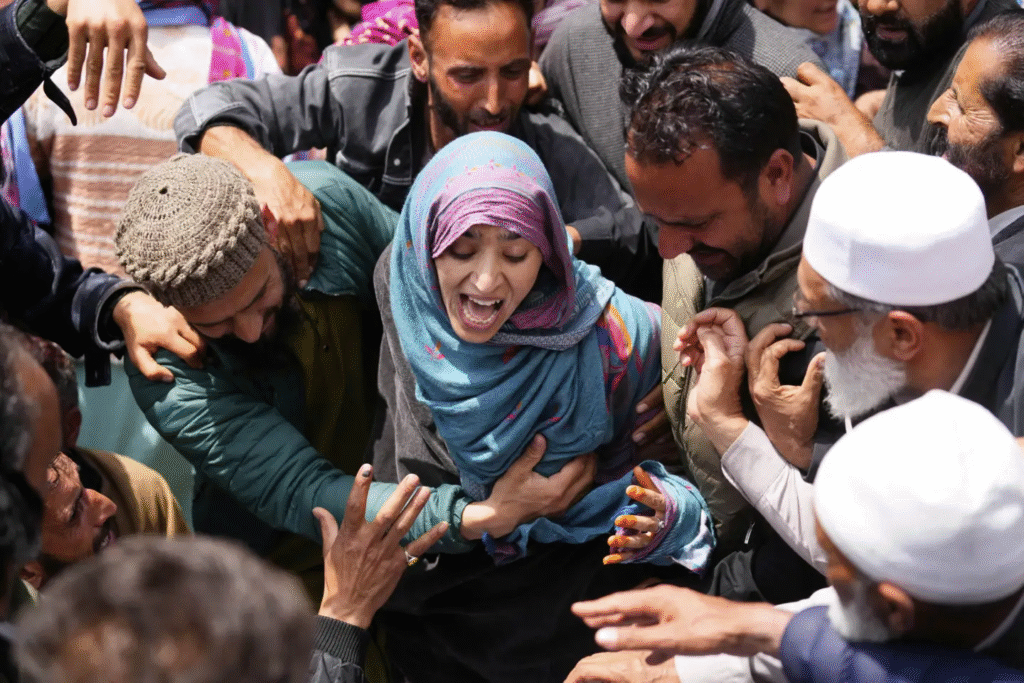Pahalgam Attack Sparks Fear of War
A deadly terrorist attack in Pahalgam, Jammu and Kashmir, on April 22, 2025, has reignited tensions between India and Pakistan. The attack killed 26 people, mostly tourists, in a scenic meadow.

India blames Pakistan for supporting the attackers, while Pakistan denies involvement. This has led to daily ceasefire violations along the Line of Control (LoC), the de facto border dividing Kashmir.
Residents near the LoC, who enjoyed years of relative peace, now fear a return to conflict. Both nations have taken harsh steps, raising concerns about a wider war between the nuclear-armed neighbors.
What Happened in Pahalgam?
On April 22, suspected militants emerged from forests near Pahalgam, a popular tourist spot in Indian-administered Kashmir.
They opened fire on a group of mostly Hindu male tourists in Baisaran Valley, killing 25 tourists and one local pony rider. The attack, the deadliest in Kashmir in 25 years, was linked to the Pakistan-based Lashkar-e-Taiba (LeT) group by India’s National Investigation Agency.
India claims Pakistan’s intelligence agency, the ISI, helped plan the attack. Pakistan rejects these claims, calling for an impartial investigation. The attack has triggered a wave of anger in India, with demands for strong retaliation.
Why Is the LoC Important?
The Line of Control is a 740-kilometer boundary separating Indian-administered Jammu and Kashmir from Pakistan-administered Kashmir.
Established after the 1947 partition of India and Pakistan, it is not a formal international border but a heavily militarized ceasefire line.

The LoC is critical because both countries claim the entire Kashmir region, leading to wars in 1947, 1965, and 1999. It is a flashpoint for cross-border firing, militant infiltrations, and military standoffs. The LoC’s strategic importance lies in its role as a buffer between two nuclear powers, making any escalation risky for regional stability.
Background of India-Pakistan Tensions
The roots of the conflict trace back to 1947, when British India was divided into India and Pakistan. Kashmir, a princely state, became a disputed territory. India and Pakistan have fought three wars over Kashmir, with the LoC emerging as the dividing line.
An armed insurgency in Indian-administered Kashmir, backed by some Pakistani elements, has simmered since the 1980s, killing thousands. Ceasefires, like the one in 2003, brought periods of calm, but attacks like Pahalgam disrupt peace.
India accuses Pakistan of sponsoring terrorism, while Pakistan claims India suppresses Kashmiri self-determination. The 2019 Pulwama attack, which killed 40 Indian soldiers, led to Indian airstrikes in Pakistan, showing how quickly tensions can escalate.
Recent Escalations and Tit-for-Tat Measures
Since the Pahalgam attack, both countries have taken aggressive steps. India suspended the Indus Waters Treaty, closed its airspace to Pakistani flights, and expelled Pakistani diplomats.
It also blocked social media accounts of Pakistani celebrities and cricketers in India. Pakistan retaliated by suspending trade, banning Indian flights, and appointing a new security adviser. For nine consecutive nights, Pakistani troops have fired across the LoC, with India responding.
No casualties have been reported, but the exchanges have shattered a fragile ceasefire. Pakistan fears an Indian military strike, possibly targeting figures like Hafiz Saeed, a known militant leader.
Impact on LoC Residents
Communities along the LoC are bracing for the worst. In Pakistan-administered Kashmir, over 1,000 religious schools have closed, and residents are stockpiling food.
People are cleaning bunkers to prepare for potential shelling. In Indian-administered Kashmir, tourist spots are deserted, and Kashmiris face harassment in other parts of India.
India has detained suspected separatists and demolished rebels’ homes, adding to local fears. After years of calm, villagers who rebuilt lives now worry about a return to the violence of the 1990s. One resident told Al Jazeera, “Everyone lives in fear.”
Global Response and Diplomacy
The international community is urging restraint. U.S. Secretary of State Marco Rubio called on both nations to de-escalate, supporting India’s right to defend itself while asking Pakistan to cooperate in the investigation.

The European Union and the U.K. condemned the attack and called for dialogue. Saudi Arabia, Qatar, and Kuwait expressed concern, with Pakistan seeking their help to pressure India. China backed Pakistan but urged both sides to avoid conflict.
The United Nations Security Council may discuss the issue, but a diluted statement after the attack avoided fully supporting India’s probe, reflecting global caution.
Why This Matters
The Pahalgam attack has pushed India-Pakistan relations to a breaking point. With both nations armed with nuclear weapons, any miscalculation could lead to catastrophic consequences. The LoC, as the frontline of this rivalry, is a barometer of their conflict.
The attack has also fueled domestic anger in India, with political leaders demanding action, while Pakistan’s economy, already fragile, has seen its stock market crash.


 Pakistan wins tech race against India, says IT minister
Pakistan wins tech race against India, says IT minister  Bilawal lauds journalists, Gen Z for exposing India’s narrative
Bilawal lauds journalists, Gen Z for exposing India’s narrative  Iranian President Pezeshkian to Visit Pakistan on First Official Trip
Iranian President Pezeshkian to Visit Pakistan on First Official Trip  Trump’s 25% Tariff Threat Sparks Major Political Storm in India
Trump’s 25% Tariff Threat Sparks Major Political Storm in India  ICCI invites Bangladesh to boost investment in Pakistan
ICCI invites Bangladesh to boost investment in Pakistan  US and Pakistan Seal New Trade Deal with Promises and Oil
US and Pakistan Seal New Trade Deal with Promises and Oil